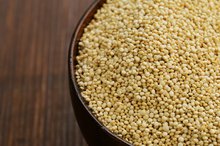What does fact checked mean?
At Healthfully, we strive to deliver objective content that is accurate and up-to-date. Our team periodically reviews articles in order to ensure content quality. The sources cited below consist of evidence from peer-reviewed journals, prominent medical organizations, academic associations, and government data.
The information contained on this site is for informational purposes only, and should not be used as a substitute for the advice of a professional health care provider. Please check with the appropriate physician regarding health questions and concerns. Although we strive to deliver accurate and up-to-date information, no guarantee to that effect is made.
Wheat bran is the edible outer layer of the wheat grain, separated from the rest of the grain during sifting. For most individuals, wheat bran provides a good source of dietary fiber that helps maintain digestive health. For those with an allergy or intolerance to wheat, however, wheat bran can trigger mild to severe reactions that affect overall health. As a result, allergic individuals should avoid wheat bran and other wheat products.
Wheat Allergy Basics
A wheat allergy occurs when the body's immune system mistakenly identifies a protein found in wheat as a threat, creating antibodies in response. These antibodies trigger a reaction whenever an individual consumes wheat bran or other wheat products. According to the Asthma and Allergy Foundation of America, the proteins that potentially cause allergies include albumin, globulin, gliadin and gluten 2. Most true allergies to wheat occur during early childhood and fade as children age. Very few adults have wheat allergies.
- A wheat allergy occurs when the body's immune system mistakenly identifies a protein found in wheat as a threat, creating antibodies in response.
- These antibodies trigger a reaction whenever an individual consumes wheat bran or other wheat products.
Allergy Versus Intolerance
Gluten Sensitivity & Severe Body Muscle Aches
Learn More
The most common example is celiac disease, an intolerance to the gluten protein that causes damage to the small intestine whenever food containing gluten passes through, eventually resulting in poor nutrient absorption.
Symptoms
In most cases, an allergic reaction begins several minutes to two hours after consuming wheat bran or other food products containing the offending protein. Common symptoms include:
- irritation of the mouth
- hives
- watery eyes
- nausea
- vomiting
- diarrhea
- nasal congestion
More severe symptoms such as anaphylaxis -- a reaction causing dizziness, rapid heartbeat and severe difficulty breathing -- may also occur and require immediate medical attention. Symptoms of wheat intolerance generally stay within the digestive system.
Other Food Products to Avoid
What Is an Amaranth Allergy?
Learn More
Aside from wheat bran, any product that lists wheat, gluten, albumin, globulin or gliadin could trigger an allergic reaction. Additional wheat products that may seem less obvious include:
- gelatinzed starch
- hydrolyzed vegetable protein
- vegetable gum
- vegetable starch
- semolina
- durum
- bulgur
- farina
Pre-packaged cookies, crackers, pasta, cereals and baking mixes also typically contain wheat. Carefully check the ingredients listed on any product before you buy.
Possible Substitutions
Queensland Health states that, while those with a reaction to wheat may also have reactions to other grains, rice bran and oat bran often prove tolerable. Common wheat substitutions in general include:
- products made with rye flour
- potato flour
- potato starch
- rolled oats
- rice flour
- cornmeal
- corn starch
Related Articles
References
- University of Kentucky -- College of Agriculture; Living Wheat-Free; Sandra Bastin, PhD, RD, LD; August 2005
- Asthma and Allergy Foundation of America; Wheat Allergy; 2005
- Cianferoni A. Wheat allergy: diagnosis and management. J Asthma Allergy. 2016;9:13-25. doi:10.2147/JAA.S81550
- Salcedo G, Quirce S, Diaz-perales A. Wheat allergens associated with Baker's asthma. J Investig Allergol Clin Immunol. 2011;21(2):81-92.
- Scherf KA, Brockow K, Biedermann T, Koehler P, Wieser H. Wheat-dependent exercise-induced anaphylaxis. Clin Exp Allergy. 2016;46(1):10-20. doi:10.1111/cea.12640
- Pacharn P, Vichyanond P. Immunotherapy for IgE-mediated wheat allergy. Hum Vaccin Immunother. 2017;13(10):2462-2466. doi:10.1080/21645515.2017.1356499
- Czaja-Bulsa G, Bulsa M.What Do We Know Now about IgE-Mediated Wheat Allergy in Children?Nutrients. 2017 Jan 4;9(1). pii: E35. doi: 10.3390/nu9010035.
- Pacharn P, Vichyanond P.Immunotherapy for IgE-mediated wheat allergy.Hum Vaccin Immunother. 2017 Oct 3;13(10):2462-2466. doi: 10.1080/21645515.2017.1356499.
Writer Bio
Caitlynn Lowe has been writing since 2006 and has been a contributing writer for Huntington University's "Mnemosyne" and "Huntingtonian." Her writing has also been in "Ictus" and "Struggle Creek: A Novel Story." Lowe earned her Bachelor of Arts degree in English from Huntington University.









